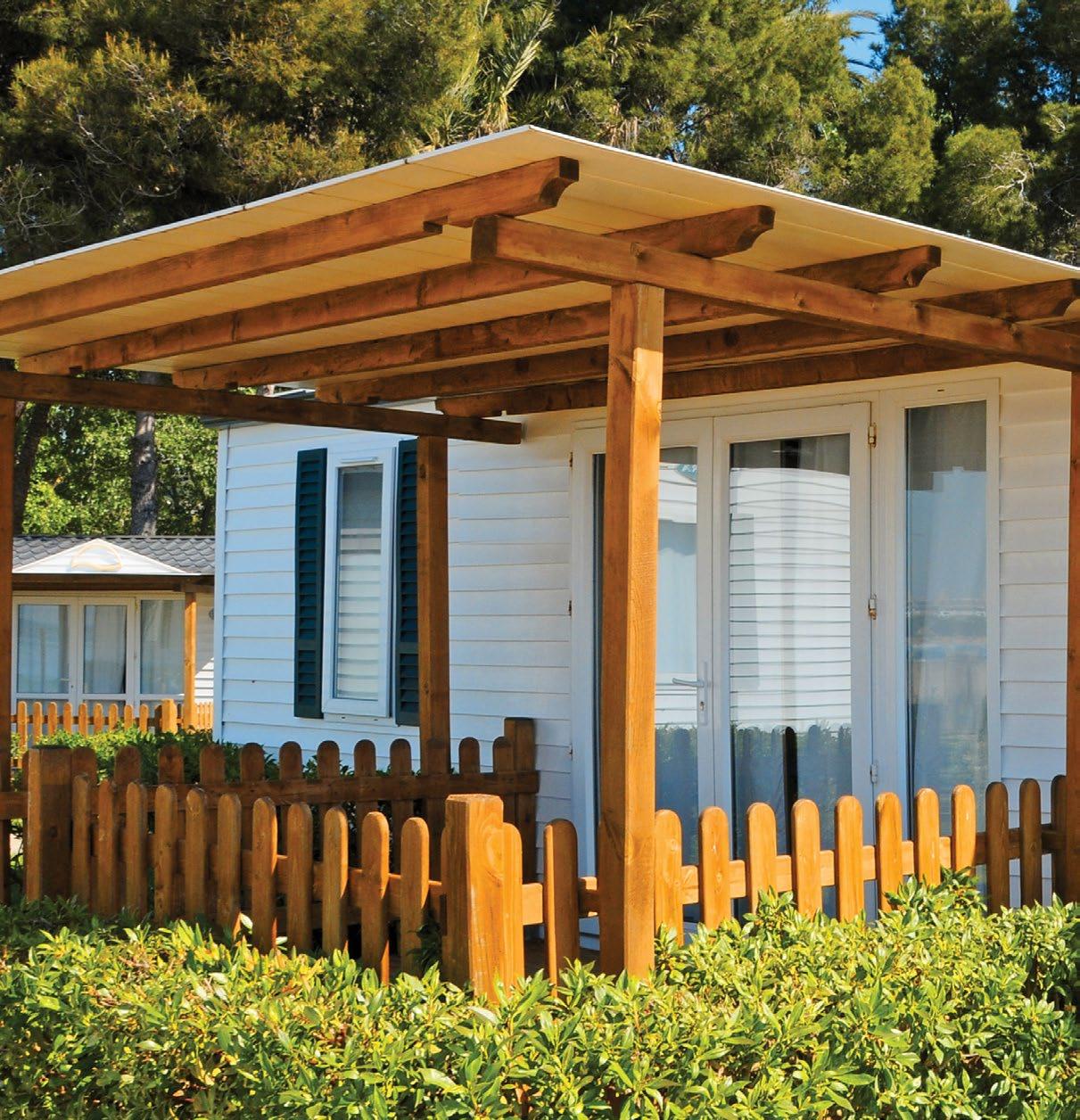
8 minute read
Mobile Homes: Expand Your Inspection
by ASHI
MOBILE HOMES:
EXPAND YOUR INSPECTION
Advertisement
By Inspect.com
Inspect.com is an online marketplace for the public to connect with qualified inspectors across the country. Get discovered and share your expertise. Add your listing to Inspect.com.
The opinions expressed in this article are those of the authors only and do not necessarily reflect the opinions or views of ASHI. The information contained in the article is general and readers should always independently verify for accuracy, completeness and reliability.
Mobile homes have special considerations that home inspectors can learn about to expand their expertise and their business.

By the time a home inspector visits a client’s mobile home, the home will be in place, ready for a move-in or a sale. But mobile homes, also called manufactured homes, carry with them a history, starting with the factory where they were built to be moved to a permanent site. A mobile home that is ready for inspection may have been pulled by a truck for hundreds or thousands of miles before arriving at its installation site. And after it arrived at its destination, a special tractor was used to maneuver around tight angles and into position and set the home in place.
Because of the need to transport them, mobile homes are lightweight, have unique electrical and plumbing systems, and have roofing that can glide with ease under a freeway overpass. Because of these factory and moving constraints, a mobile home inspection requires a keen eye for safety for both systems and structure. To learn how a mobile home is delivered to a site, check out this video link (https://youtu.be/Bza3tFy8VpU) featuring Franco Perez from Franco Mobile Homes. Mobile homes are tightly regulated under the U.S. Government Housing and Urban Development (HUD) guidelines outlined in Title 24: (www.ecfr.gov/cgi-bin/text-idx?SID=a2c5655a37054c584f7dd6a0ed240fb8&node=pt24.5.3285&rgn=div5). These guidelines originated in the State of California’s Title 25 guidelines: (https://govt.westlaw.com/calregs/Browse/Home/California/ CaliforniaCodeofRegulations?guid=I1D6C3650EBF911E09DB1FA8A2A044D67&originationContext=documenttoc&transitionType=Default&contextData=(sc.Default). For example, in California, every mobile home must be certified to prove there are no health or safety defects. Information in California’s MOBILEHOME PARK INSPECTION BOOKLET is a gold standard guide to inspection points for home inspectors anywhere. (Source: https:// www.hcd.ca.gov/building-standards/manufactured-modular-factory-built/docs/hcdmp200.pdf) A “health and safety inspection” is a necessary component of a manufactured home sale to determine the safe condition of the home.
INSPECTION TIPS
Transportation Damage
Brand new mobile homes can suffer damage from transportation. Warping and leaks are two main issues that result from improper transportation. Check that walls and flooring are true. Doublecheck for any signs of water damage from leaks.
No Permanent Foundation
Mobile homes do not have a permanent foundation. Piers and jacks are used to support the home. Supporting earthquake bracing or tie-downs are used to ensure the home stays properly positioned on the jacks. Mobile homes are especially prone to earthquake damage. Homes in earthquake areas need additional earthquake stabilization.
Source: Minimizing Damage and Repair Costs to Manufactured Homes During an Earthquake, U.S. Department of Housing and Urban Development (HUD).
Secure tie-downs for mobile homes can prevent the home from jumping off the piers or jacks. But in earthquake territory, an additional earthquake resistant bracing system (ERBS) helps stabilize the home against both vertical and horizontal movement.
Electrical
Because the frame of the house is metal, the house can suddenly become electrically charged. The mobile home has a four-wire bonded electrical system that ensures that if there’s any kind of stray electricity in any part of the home, it takes that power directly to ground.
Home inspection checklist:
• Electrical panel not properly protected from weather or not rated for outdoor use, rusted, corroded, unsafe: fire and shock risks
• Flickering lights: due to use of aluminum wiring, do-it-yourself or amateur wiring or other defects
• Improper connection to site, service entry, support, clearance over roofs
• Loss of electrical power in or along one side or in one half of the home
• Do-it-yourself wiring, exposed splices, bad or no
GFCI, lamp cord wiring
• Blocked access panel
• Abandoned fixtures or boxes left open to weather
• Loose, falling fittings and lights and fixtures inside and out
• GFCI missing at baths, kitchens, outside, or mis wired
• Exterior electrical receptacles mis wired, incompletely installed, missing weatherproof covers
• Exposed wiring without conduit installed (including sub-area)
• Three-prong outlets at dryers (a four-prong plug is required)
• Electrical outdoors must be watertight
Plumbing
Because mobile homes are designed to be lightweight, plumbing materials are usually made of plastic or soft metals. These materials are lighter and more affordable than standard metal. Often, the pipes are smaller and not as securely placed. You may see pipes laying under cabinets. Some older mobile homes may still have polybutylene plumbing. This soft material is prone to leaks. Recommend replacing polybutylene pipes to avoid expensive pipe leak repairs. Pipes may not be strapped, especially in older homes. You may see supply pipes running through cabinets or floor joists without strapping. Also, the venting system can be modest and vent under sinks instead of being routed outside the structure. Note any drainage cleanout access. Some mobile homes have none.
Porches, Stairs and Freestanding Attachments
Most mobile homes rest above ground on the support structure, so access to the home is by stairs up to the doors. Be aware of any trip hazards like uneven rises, or stair widths. All stairways should have rails for support. Most importantly, screen rooms, additions, alterations, porches and stairs need to be completely freestanding. Because of the lightweight construction, mobile homes cannot support attached or bolted additions. They will drag down the mobile home. If your client is considering additions or alterations, inform them that modifications need to be independently self-supporting.
Water Heater
According to HUD’s Homeowners’ Center, all manufactured homes must have water heaters with a non-adjustable temperature and a pressure-relief valve. The water heater installed must comply with the local building codes of the state in which it is located and must be owned by the homeowner. Standard water heaters are generally not HUD-approved because of the square intake vent at the base, which is not completely sealed. Mobile home water heaters look different. Mobile home water heaters have the cold water inlet connection on the side and the hot water outlet connection on top. They have a securing strap kit to stabilize the tank. Gas-powered mobile home water heaters have interchangeable gas and propane orifices so that the water heater can be converted from natural gas to propane gas operation.
Don’t let a big down payment keep you from the coverage you deserve
Switch to InspectorPro’s 12-pay program to make your insurance policy payments easy and convenient.
Not available in New Jersey. Some restrictions apply. Talk to an InspectorPro broker for details.

Actual leak location
Apparent leak location
Wet insulation
Mobile Home Roof
Because mobile homes are transported, they often have a low pitch or flat roof. Because of this, the roof is prone to leaks. As an inspector, you know how tricky. Locating roof leaks can be. (Source of diagram: https://www.dummies. com/home-garden/exteriors/roofing/how-to-find-a-leak-ina-roof/).
Check for signs of leaks:
• Water behind wall siding • Water on ceiling insulation and wood • Mold and mildew in the attic space • Wet carpet • Mold on ceiling or walls appearing as dark spots • Water spots on ceiling • Peeling wallpaper or paint • Sagging or bowing of ceiling, walls, gutters, siding
Gas Connection
Mobile homes are highly flammable, so special consideration is mandated for gas connections to mobile homes. The gas line must connect outside the home with flexible connection tubing. All appliances must have a valve above the floor and directly adjacent to the appliance in the same room. A shutoff valve that disconnects the gas supply shall be located in the home. A shutoff valve at an LP tank is acceptable.
(Source of diagram on P27: Weld County, Colorado, MOBILE & MANUFACTURED HOME INSTALLATION REQUIREMENTS. https://www.weldgov.com/UserFiles/Servers/Server_6/File/ Departments/Building/Building%20Permits/Construction%20 Handouts%20&%20More%20Information/Residential/Manufactured%20Installation%20Requirements.pdf )
6" Manufactured Home
Appliance Connector
Minimum Pressure 10# for 15 Minutes (No Drop in Press.)
Gas Shut-off Valve
Factory–Coated 3/4" Black Pipe
Adequate Combustion Air
Water heaters and furnaces need oxygen in the air to properly function. Mobile homes often house these appliances in small, closed spaces. Without adequate fresh air ventilation, the appliance will operate inadequately with increased maintenance costs. More importantly, for safety, inadequate combustion air can build up dangerous levels of carbon monoxide. Mobile home water heaters are specifically designed to need less air. Check that the appliances are stamped for mobile home use. Also, check to ensure that all vents and louvres are not blocked.
A View from the Real Estate Agent Side
Mobile home real estate agents expect home inspectors to be familiar with the differences between mobile homes and single-family dwellings.
For example, Franco Perez advises home inspectors:
As a dealer or agent, we want to obtain lots of information from the inspection report, to be able to portray what is important to our client. The easier it is for our agents to identify what is a priority and what isn’t, the more we’d love to work with that inspector. Our job as a dealer or agent is to make sure that our clients are protected and taken care of in the best possible way. There are specific areas that can help improve mobile home inspections. In a typical health and safety inspection, a thorough report is constructed, containing several pages of any issues found. It’s necessary to make sure the report is as clear and specific as possible. This could be done by adding multiple images, with added annotations such as arrows or circles of the issue. Some inspectors have even offered a video footage walkthrough to explain each issue. Overall, a mobile home inspection report should be very detailed and organized in a way that can be easily understood.
Your Inspection Is Essential
Health and safety are prime requirements for mobile home transactions. Your knowledge and expertise will help sellers and buyers rest assured that the home is safe for loved ones. Knowing the special considerations for manufactured homes will ensure that your home inspection is thorough and meets the needs of the structure.
Resources for more information: CA Housing & Community Development Title 25 (https://www. hcd.ca.gov/manufactured-mobile-home/mobile-home-parks/ laws-and-regulations.shtml) CA healthy home definitions (pp. 2-4) (https://nchh.org/ resource-library/HH_Codes_CA_9-9-07.pdf) Rights of CA mobile home park residents (https://www.hcd. ca.gov/manufactured-mobile-home/mobile-home-ombudsman/mobilehome-resident-rights.shtml)






